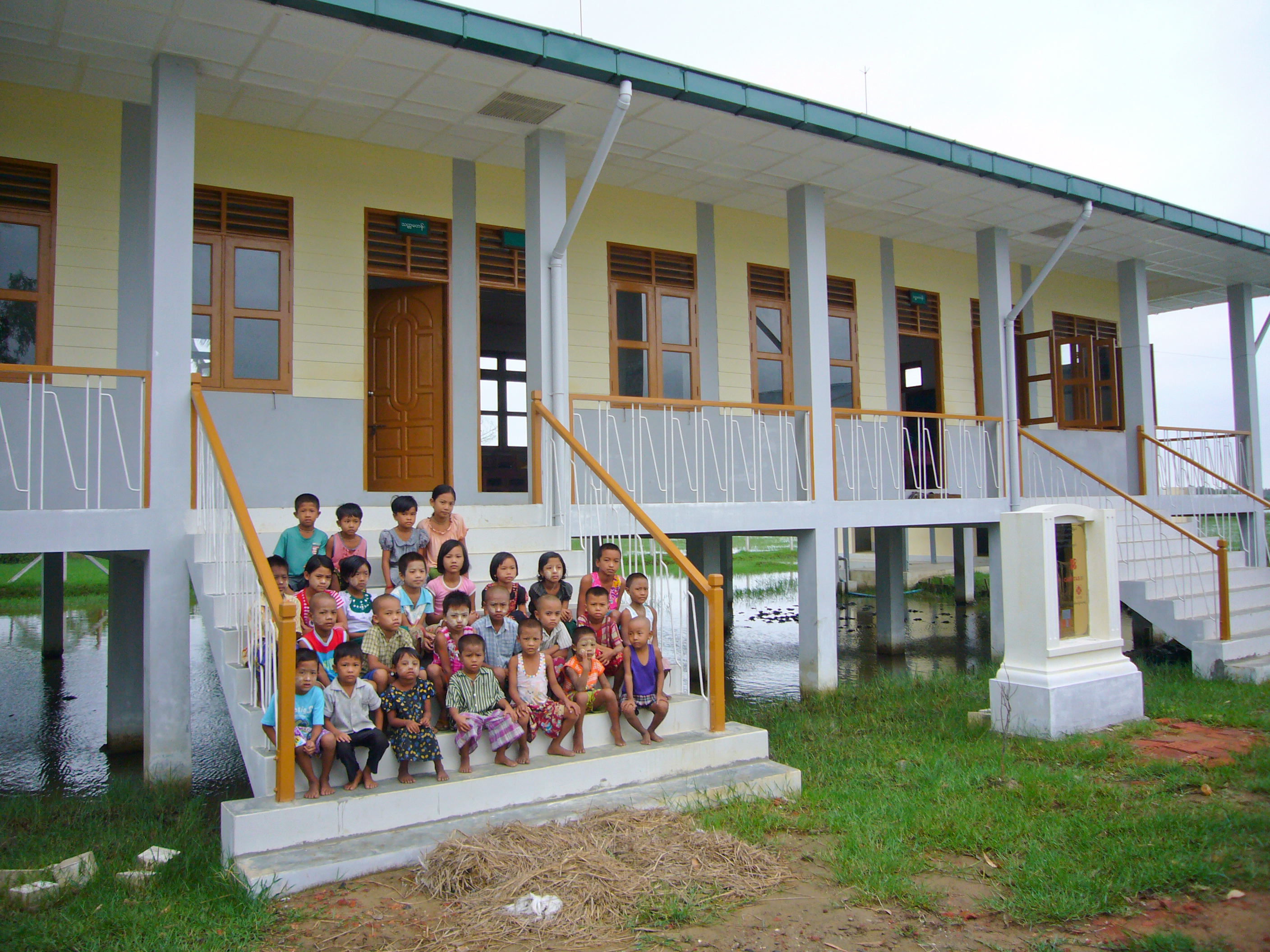Swiss-funded school doubles as cyclone shelter

Schools erected by a Swiss charity in the Irrawaddy delta in Myanmar are not only the most modern in the region. In the event of a natural disaster, they would also serve as shelter.
A clump of aquatic vegetation is wound around the propeller. The motor, designed for a tractor, sputters. Three feeble revs are followed by silence. The pleasant rustling of the leaves in the wind can be heard. In the palm trees on the riverbank, a small bird begins to sing.
Then another crank, and the motor starts. The boat begins its journey along this branch of the Irrawaddy, the great river that traverses Myanmar. We proceed with caution along the muddy channel. The obstacles to avoid – water buffaloes trying to keep cool – are as big as the boat itself.
“Once there were a lot more animals. Cows and buffaloes were swept away by Nargis,” U Win Min Oo of the Myanmar Business Executives Association (MBE), a local voluntary group, tells swissinfo.ch.
The cyclone that devastated the Irrawaddy delta in May 2008 also killed over 130,000 people. The huts of foliage and bamboo could not stand up to the power of the wind, which at times reached 200km per hour.
“A year after Nargis, the signs of the disaster were still visible. Of all the palm trees only the trunks were left standing,” recalls U Win Min Oo.
School for survival
Ma Lai Lai Naing, a woman of about 40, succeeded in getting her three children to safety. Everything else – home, food supplies and personal effects – was lost. “We spent the night out in the rain. All the neighbouring huts had collapsed,” she recalls.
Three days later, well before help arrived, Ma Lai Lai Naing went back to the river. She and her husband rebuilt their own house. It is still made of wood and bamboo and thus too fragile to stand up to another cyclone.
However, if the elements were to be unleashed again, the woman would now know where to bring her family to safety. In the neighbouring village, less than half an hour’s journey by boat, a solid structure is waiting to accommodate them.
Kyaik Ka Bar, with 580 families, is one of 36 villages in which the charity Caritas Switzerland has rebuilt a multi-purpose school. With the help of MBE, its local partner, a two-storey cement structure was put up. In case of natural disaster, it can act as a place of refuge for those living in the area and fit up to 250 people.
“It is without doubt the most modern and secure structure in the whole region. Not even in Yangon are there any schools like that,” notes U Win Min Oo, the engineer in charge of the project. The walls, he explains, are made of wood. “The water can break them easily and pass through the lower level without damaging the basic structure.”
Finished in six months at a cost of about $150,000 (SFr141,000), this school also has two big cisterns to accumulate rainwater. Once this has been filtered it is perfectly drinkable, says U Win Min Oo.
Tsunami test
At Kyaik Ka Bar, cyclone Nargis did not cause loss of life, although the water level of the river increased by a metre within half an hour. “We had been warned, but a lot of people still thought it was just an ordinary storm,” recalls Khin Maung Oo, a member of the school management committee.
“We took refuge in the temple, which stands on higher ground, and on rooftops. We lost all the rice we had stored and the water ruined the crops.” Elders in the village, as Khin Maung Oo points out, had never seen anything like it.
To be able to stand up to the strong winds which sometimes blow in this area, some houses have been reinforced with pieces of wood and their roofs attached to the structure. “But when it starts raining or a storm is forecast, people suddenly start getting very worried.” This happened last April when an earthquake in Indonesia triggered a tsunami warning.
Fortunately the giant wave never materialised. The alert was, however, a good opportunity to test the evacuation plans.
Thanks to maps which indicate the location of health centres, particularly solid houses – or on the other hand, houses where particularly vulnerable people live – “everyone knows where to go and where to store their possessions and food supplies”, explains Khin Maung Oo. In the new school, “priority is given to children, women, and old people”.
Myanmar ranks among the countries most at risk from the combined effects of climate change, according to the latest report (March 2012) by the Asian Development Bank.
Poverty and dependence
After several hours by boat through the endless rice paddies of the delta, we arrive at Sein Lay Gone, a little village a few miles from the sea. Judging by the crowd of curious onlookers in front of the new school, you would think that all 230 students were here to meet us.
The atmosphere, lighthearted and cordial, gets a bit more tense when the engineer from MBE and the community representatives start to talk about maintenance of the school. “Our message is that it’s their school. It’s up to them to look after it,” insists U Win Min Oo.
Organising suitable maintenance committees, successfully done elsewhere, is not that easy. On one hand, explains U Win Min Oo, this area was particularly hard hit by the cyclone and got a lot of aid from various countries and organisations. “So a mindset of dependence established itself.”
On the other hand, he adds, it should be said that this community was and still is a poor one. Once the emergency was over and the rebuilding phase completed, everyday reality set in again. “We need work, especially after harvest time,” says a rice farmer, lamenting the drop in production due to the extreme saltiness of the ground, one of the after-effects of the cyclone.
To provide new opportunities for the peasants, the partner association of Caritas Switzerland has started up micro-credit and skill training projects. “They can learn, for example, how to repair a piece of machinery or a farm vehicle”, explains U Win Min Oo.
What worries fishermen in the area is not the future running of the school, which is still shiny new and showing no cracks.
Several days ago, ‘ngaty’, which are salt-water fish, started appearing in the river. “Usually” a fisherman explains, “they mean a spell of bad weather is coming.”
If another cyclone were to hit the region, the houses would again just be swept away, admits U Win Min Oo. “But now at least the people have somewhere safe to go.”
On May 2, 2008, the coast of Myanmar near the Irrawaddy delta was hit by tropical cyclone Nargis.
One of the most destructive in history, this category four cyclone (the scale is one to five) tore across the region with 200km per hour winds.
95% of the housing in the entire delta was destroyed. Estimates are that about 130,000 people perished and a further 2.5 million were otherwise affected by the cyclone.
The international community condemned the attitude of the then military regime, accusing it of impeding relief efforts.
Swiss Solidarity, a nationwide charitable organisation, collected donations totalling SFr8.7 million.
Swiss government humanitarian aid also participated in the rebuilding phase in the Irrawaddy delta.
The Swiss Agency for Development and Cooperation (SDC) has put up 25 schools so far. Another ten will be finished by spring 2013. These structures can accommodate about 4,500 students and in an emergency they can be used as cyclone shelters.
Each building can accommodate 700 to 1,000 people and is equipped with cisterns and water filtration.
The buildings are designed to resist winds of 200km per hour and earthquakes measuring six on the Richter scale.
Since 2009 about SFr6 million have been budgeted for the activities of SDC in the region.
(Translated from Italian by Terence MacNamee)

In compliance with the JTI standards
More: SWI swissinfo.ch certified by the Journalism Trust Initiative













You can find an overview of ongoing debates with our journalists here . Please join us!
If you want to start a conversation about a topic raised in this article or want to report factual errors, email us at english@swissinfo.ch.